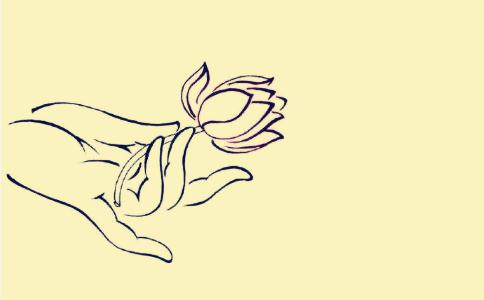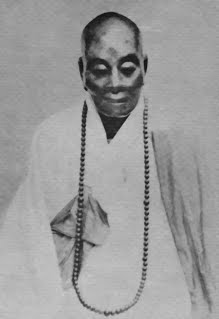Chán 禪 is a branch of Buddhism that developed in China and whose origin is attributed to Bodhidharma (菩提達磨 Pútídámó), an Indian monk* of the V or VI century. Subsequently, Chán Buddhism expanded to Southeast Asia and Japan, where it was named Zen.
Chán differs from other Buddhist schools by attaching greater importance to meditation, intuition, and master-disciple relationships than to ritual, intellectual understanding, or study of sacred texts.
In China emerged the idea of a "separate transmission" of the Buddhist dharma, external to the scriptures, which transcended language and only took place directly from master to disciple. Chán traces the origin of this transmission to the Flower Sermon (拈花微笑 niān huá wéi xiào). According to this story, one day Śākyamuni Buddha** gathered his disciples for a dharma talk. When the Buddha arrived and took a seat in front of them, he remained silent for a long time, during which his disciples began to wonder about the reason for his silence. Then the Buddha raised a flower before his eyes; everyone looked without understanding the meaning of this gesture, and only his disciple Mahākāśyapa smiled. In response to Mahākāśyapa's smile, the Buddha said: "the true Dharma is not found in words, but is a special transmission outside the scriptures, which I entrust to Mahākāśyapa".

Chán thus conceives the teaching of the Buddhist dharma as an esoteric transmission, produced from "mind to mind" in a nonverbal way. This transmission would have been passed on from the Buddha Śākyamuni, through twenty-eight Indian patriarchs beginning with Mahākāśyapa to Bodhidharma, in an uninterrupted line in which each master would have revealed the true dharma to one of his disciples, similar to how the flame of a candle lights another flame before being extinguished.
Thus, a system of transmission of the Buddhist teachings was developed in China according to which a master was only accredited to teach in respect of his position in a certain lineage that traced his ancestry to the early patriarchs. What was transmitted was the understanding of the ultimate reality, and somehow the master pointed to the buddhic nature of the disciple, present in all beings but obscured by common thought, thus being he able to realize it.
However, the first written sources that speak of the Flower Sermon date back only to the 14th century. The written records of lineages, tracing their origins to India, thus intended to establish Chán as a legitimate school.
The Chinese patriarchs
Bodhidharma would therefore have introduced this transmission in China; he is thus considered the 28th patriarch of India and the first of China. The lineage continued for five more transmissions, first to Dàzǔ Huìkě 大祖慧可, the second patriarch, and then to Jiànzhì Sēngcàn 鑑智僧璨, Dàoxìn 道信 and Hóngrěn 弘忍, until Dàjiàn Huìnéng 大鑒惠能, the sixth patriarch.
After Huìnéng , the transmission of the dharma ceased to be conferred on a single disciple, and the lineage was divided into multiple branches.
In the Sòng 宋 dynasty, the lineages that descended from Huìnéng had already given rise to the so-called Five Schools of Chán. These five schools are: Guíyáng 潙仰, Línjì 临济, Cáodòng 曹洞, Fǎyǎn 法眼 and Yúnmén 雲門. Each of these lineages had its own particular style of practicing and understanding Chán, and yet all of them were considered legitimate heirs of the Sixth Patriarch, Huìnéng.

Statue of Huìnéng.
The legitimacy of a Chán master was based on his position on the transmission line. Today's historians believe, however, that the entire pre-Sòng lineage is a more mythical than a historical construct, which served to legitimize a particular school and its alleged possession of a special transmission. Even during the Sòng dynasty, lineages were reinterpreted and manipulated to legitimize masters and schools.
Just as in other countries monks were defined by some kind of special ordination, in China they were and are ordained within the general Buddhist order, and not within a particular school of Buddhism. Therefore, what defined a Chán master was only his possession of the transmission in the lineage. This transmission and position in the lineage were outside the aspirations of most monks, and the few who became recipients of the transmission only did so after decades of study.
Although the Chán lineage system is partially based on the systems of northern India, it achieved further development in China, where it closely resembled traditional family lineage systems.
教外別傳
jiào wài bié chuán
A special transmission outside the scriptures
不立文字
bù lì wén zì
not relying on words
直指人心
zhí zhǐ rén xīn
pointing directly to the human heart-mind
見性成佛
jiàn xìng chéng fó
seeing one's own nature and attaining Buddhahood.
Huìnéng, Sixth Patriarch of Chán
List of the Indian patriarchs:
1. Mahākāśyapa (摩訶迦葉 Móhējiāyè)
2. Ānanda (阿難陀 Ānántuó)
3. Śānavāsa (商那和修 Shāngnàhéxiū)
4. Upagupta (優婆掬多 Yōupójúduō)
5. Dhrtaka (提多迦 Dīduōjiā)
6. Miccaka (彌遮迦 Mízhējiā)
7. Vasumitra (婆須密多 Póxūmìduō)
8. Buddhanandi (浮陀難提 Fútuónándī)
9. Buddhamitra (浮陀密多 Fútuómìduō)
10. Pārśva (婆栗濕婆 Pólìshīpó)
11. Punyayaśas (富那夜奢 Fùnàyèshē)
12. Ānabodhi (阿那菩提 Ānàpútí)
13. Kapimala (迦毘摩羅 Jiāpímóluó)
14. Nāgārjuna (那伽閼剌樹那 Nàqiéèlàshùnà)
15. Kānadeva (迦那提婆 Jiānàtípó
16. Rāhulata (羅睺羅多 Luóhóuluóduō)
17. Sanghānandi (僧伽難提 Sēngqiénántí)
18. Sanghayaśas (僧伽舍多 Sēngqiéshèduō)
19. Kumārata (鳩摩羅多 Jiūmóluóduō)
20. Śayata (闍夜多 Shéyèduō)
21. Vasubandhu (婆修盤頭 Póxiūpántóu)
22. Manorhita (摩拏羅 Mónáluó)
23. Haklenayaśas (鶴勒那夜奢 Hèlènàyèzhě)
24. Simhabodhi (師子菩提 Shīzǐpútí)
25. Vasiasita (婆舍斯多 Póshèsīduō)
26. Punyamitra (不如密多 Bùrúmìduō)
27. Prajñātāra (般若多羅 Bānruòduōluó)
28. Bodhidharma (菩提達磨 Pútídámó)

Notes:
* The origin of Bodhidharma is not entirely clear. For more information on Bodhidharma, you can consult our articles: Deconstructing the Shaolin Myth (historical data on Bodhidharma and the Shàolín Monastery); Bodhidharma (his life according to popular belief).
** For more information on Buddha's life and teachings, see the article Life of the Buddha.
